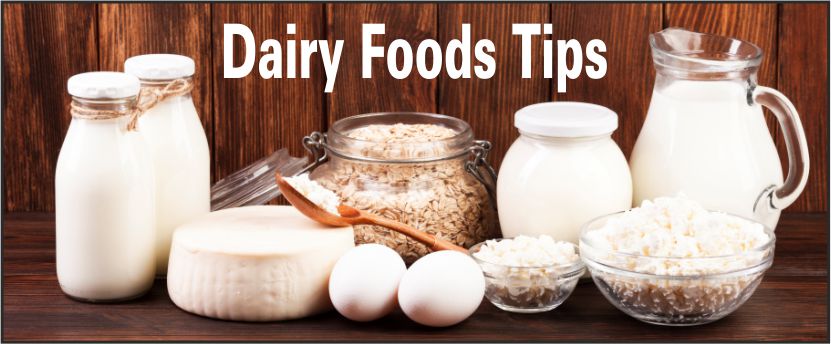Dairy Foods
Dairy foods are highly nutritious foods that are indispensable in our kitchens, as they provide easy nutrition and add flavor when combined with many foods. Here, you will find some tips about eggs and cream. For more information about other dairy foods, please click on the “tags” at the bottom of this article.
Dairy Foods: Eggs
Eggs are an excellent source of both protein and vitamins and are an extremely versatile food. They can be boiled, fried, poached, or used to thicken, emulsify, coat, bind, or glaze. Eggs are sensitive to temperature changes and should be warmed to room temperature before use.
Dairy Foods Tips: Marking Boiled Eggs
Use a food-coloring pen to mark a cross on hard-cooked eggs. The cross will distinguish them from uncooked eggs if stored together.
Dairy Foods Tips: Checking for Freshness
Dissolve 2 tbsp (30 ml) salt in 2 cups (500 ml) of water. Place the eggs in the water. If an egg sinks, it is fresh; if it floats, it is stale.
Dairy Foods Tips: Buying and Storing
- Checking for cracks: When buying eggs, move each egg gently in the carton to check that none are damaged.
- Keeping freshness: Store eggs in a carton in the refrigerator to prevent them from losing moisture and absorbing odors through their shells from strongly flavored foods nearby. Avoid poor-quality cartons.
- Storing correctly: Always store eggs with the pointed end down to center the yolk and keep the eggs fresh.
Dairy Foods: Cream
There are several types of cream, each with different properties depending on the butterfat content. The butterfat content also determines the cream’s richness, flavor, and whipping characteristics. The fatter a cream contains, the less likely it is to curdle.
Dairy Foods Tips: Storing Cream
Freezing in an ice tray: Open-freeze heavy cream in an ice-cube tray, then put the cubes into freezer bags and store them in the freezer. The cubes can be added directly to hot soups, sauces, or casseroles.
Dairy Foods Tips: Using Cream
- Heavy cream: Choose heavy cream when you need softly whipped cream for folding into mousse-type desserts or for piping. Light cream will not hold the air as well and will lose its fluffiness quickly.
- Low-fat alternative: Mix a few tablespoonfuls of plain yogurt or whipped cottage cheese into whipped heavy cream to lighten creamy desserts or cake fillings.
- Creme fraîche: Use creme fraîche as a substitute for light or sour cream in hot sauces, as it can be heated to boiling without curdling.
- Making sour cream: To make sour cream, add 1 tsp (5 ml) of lemon juice to a cup (150 ml) of light cream. Stir, and let stand until thickened.
Tip: If you would like to find more information about “Dairy Foods Tips”, click on the “tags” below.






